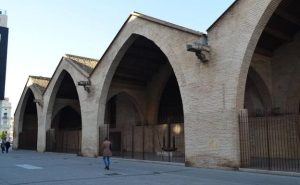
©LAS PROVINCIAS
Las Reales Atarazanas del Grao de Valencia (Comunidad Valenciana, España) son un conjunto de edificios góticos que se consideran Monumento Histórico-Artístico Nacional desde el 11 de noviembre de 1949 y Bien de Interés Cultural desde 1985 gracias a la Ley de Patrimonio Histórico.
En la década de los 90, este conjunto fue adquirido por el consistorio y restaurado por el arquitecto valenciano Manuel Portaceli Roig, siendo finalmente inaugurado en 1994 y convertido en uno de los espacios museísticos más importantes de la ciudad de Valencia.
El nombre de Atarazana proviene delo árabe Addar As-Sina’a, de la que derivan otros términos como dársena, atarazana y arsenal, traduciéndolo como taller.
La finalidad de las atarazanas, en ese momento, eran artesanales, siendo un edificio donde se construían los barcos militares y comerciales. También funcionaba como almacén para objetos y material marítimo.
La primera referencia documental que existe sobre un edificio parecido data después de la conquista de Jaime I, en 1238, quien ordenó la construcción de algún tipo de almacén que pudiera reunir todas las características para que pudiera actuar como bodega para provisiones cerca de la ciudad.
En 1284, Pedro III el Grande, concedió una licencia a los Cónsules de la Ciudad para edificar un local con el objetivo de construir y reparar los barcos que la Corona necesitara en su lucha por conseguir le trono de Sicilia. Además, también servía de almacén para útiles y aparejos de las embarcaciones. Debido al rápido crecimiento de la ciudad de Valencia, el 27 de agosto de 1338 se ordenó la construcción de unas nuevas atarazanas, obligando a una ampliación y adaptación con el paso del tiempo debido a la expansión marítima de la ciudad.
Sin embargo, fue en 1500 cuando las Atarazanas pudieron adquirir su actual disposición en planta y alzado por el acuerdo, sobre sus obras de reparación de los jurados de Valencia el 12 de agosto.
La Atarazanas fueron de titularidad municipal hasta la Guerra de Sucesión, donde pasaron a manos del rey. En 1802, la Hacienda Real las tomó como parte de las deudas al Estado. En 1840 fueron vendidas a particulares y se convirtieron en naves divididas y alquiladas por separado. Una de las naves fue utilizada como cine en 1915.
El edificio cuenta con cinco naves y una superficie total de unos 3.500m2. En las obras de este edificio, además, han participado maestros canteros como Pere Compte, quien fue el Maestro de las Obras de la Catedral de Valencia.
Actualmente, el edificio es un espacio museístico que recibe numerosas exposiciones temporales.
__
REALES ATARAZANAS
The Reales Atarazanas del Grao de Valencia (Valencian Community, Spain) are a set of Gothic buildings that are considered National Historic-Artistic Monument since November 11, 1949 and Cultural Interest since 1985 thanks to the Law of Historical Heritage.
In the 90’s, this complex was acquired by the city council and restored by the Valencian architect Manuel Portaceli Roig, finally being inaugurated in 1994 and converted into one of the most important museum spaces in the city of Valencia.
The name Atarazana comes from the Arabic Addar As-Sina’a, from which other terms such as dock, atarazana and arsenal derive, translating as workshop.
The purpose of the dockyards, at that time, were artisanal, being a building where military and commercial ships were built. It also functioned as a warehouse for maritime objects and material.
The first documentary reference that exists about a similar building dates after the conquest of James I, in 1238, who ordered the construction of some kind of warehouse that could meet all the characteristics so that it could act as a warehouse for provisions near the city.
In 1284, Peter III the Great, granted a license to the Consuls of the City to build a warehouse for the purpose of building and repairing the ships that the Crown needed in its struggle for the throne of Sicily. In addition, it also served as a warehouse for tools and equipment for the ships. Due to the rapid growth of the city of Valencia, on August 27, 1338, the construction of new shipyards was ordered, forcing an expansion and adaptation with the passage of time due to the maritime expansion of the city.
However, it was in 1500 when the Atarazanas were able to acquire their current layout in plan and elevation by the agreement on their repair works of the juries of Valencia on August 12.
The Atarazanas were municipal property until the War of Succession, when they passed into the hands of the king. In 1802, the Royal Treasury took them as part of the debts to the State. In 1840 they were sold to private individuals and were converted into warehouses that were divided and rented separately. One of the warehouses was used as a cinema in 1915.
The building has five warehouses and a total area of about 3,500 m2. Master masons such as Pere Compte, who was the Master Builder of the Valencia Cathedral, participated in the construction of this building.
Currently, the building is a museum space that receives numerous temporary exhibitions.
__

